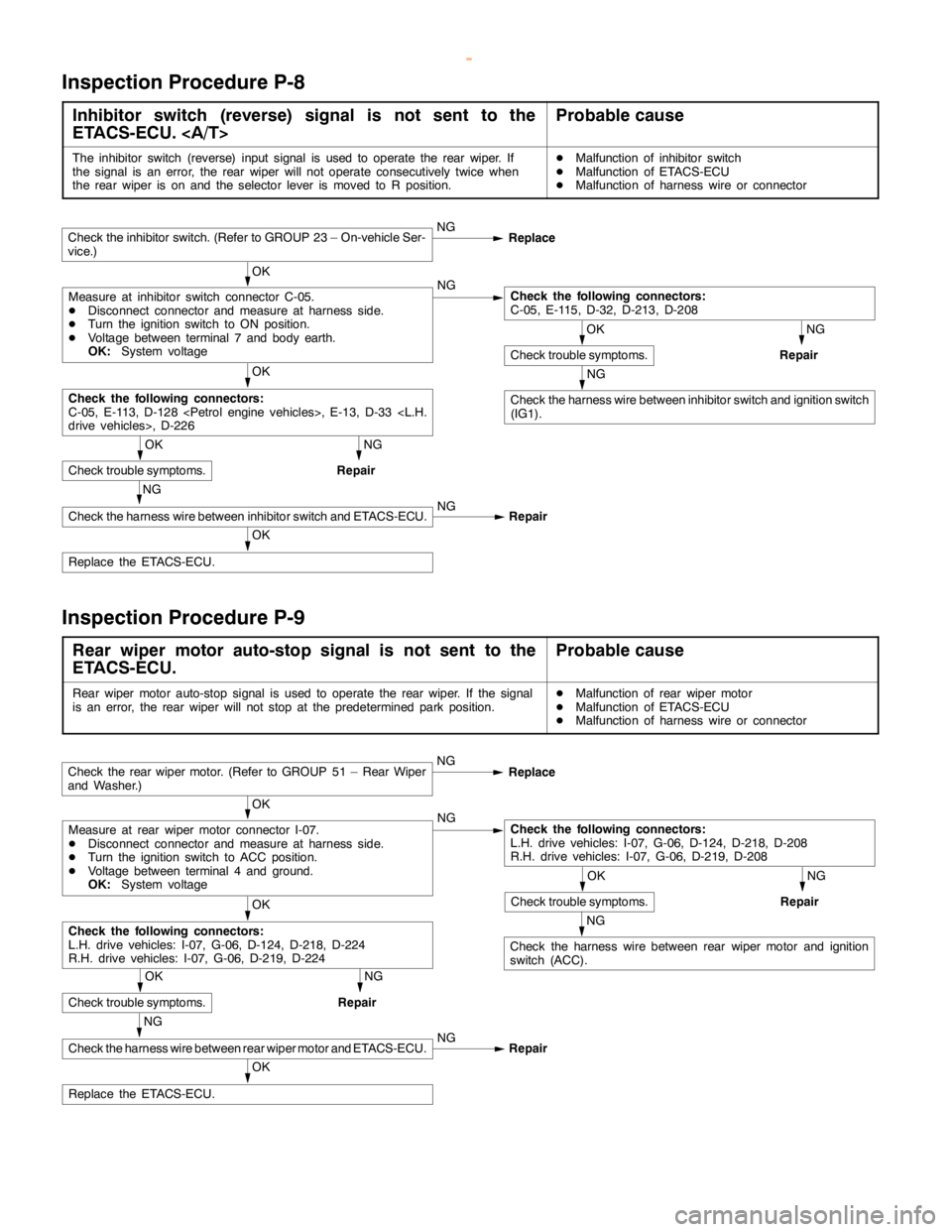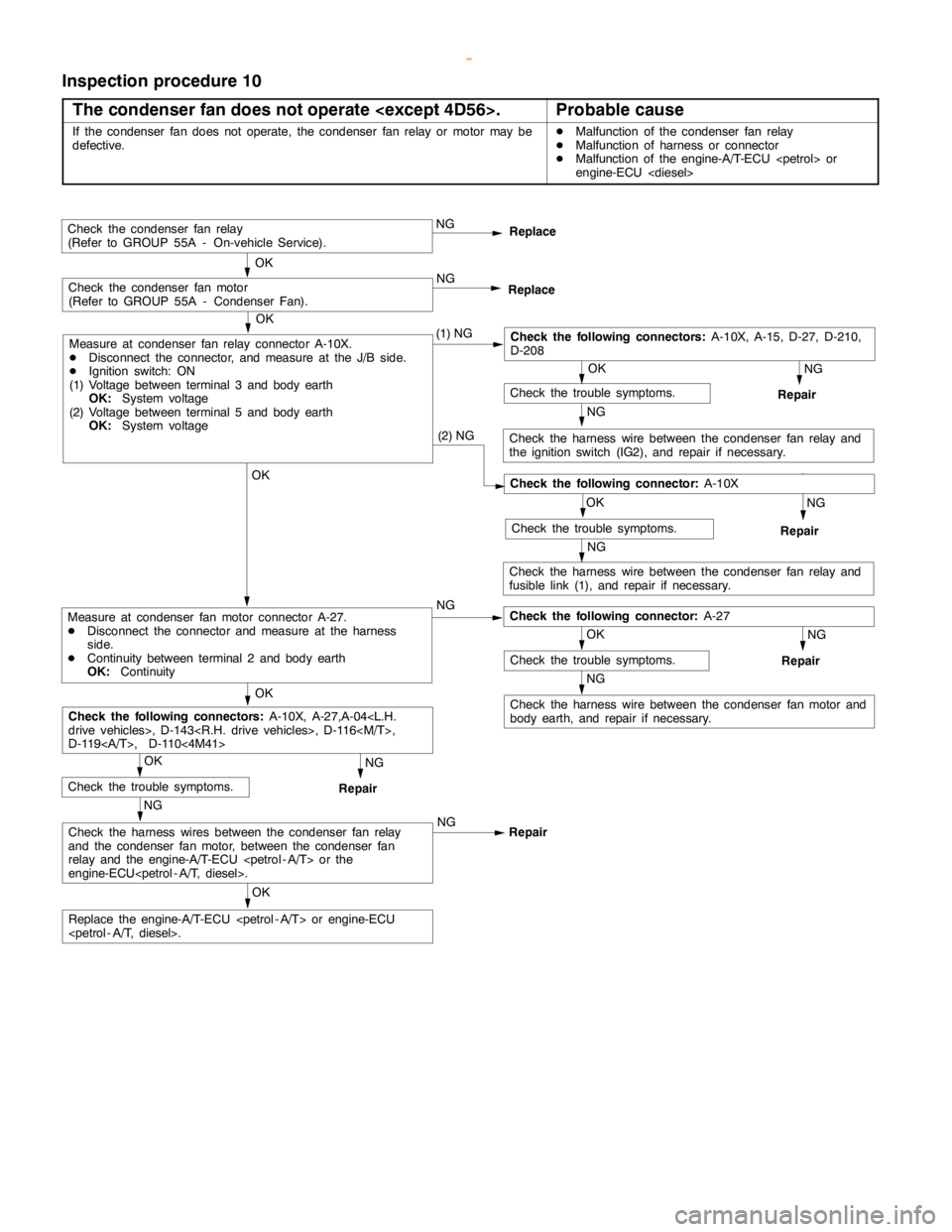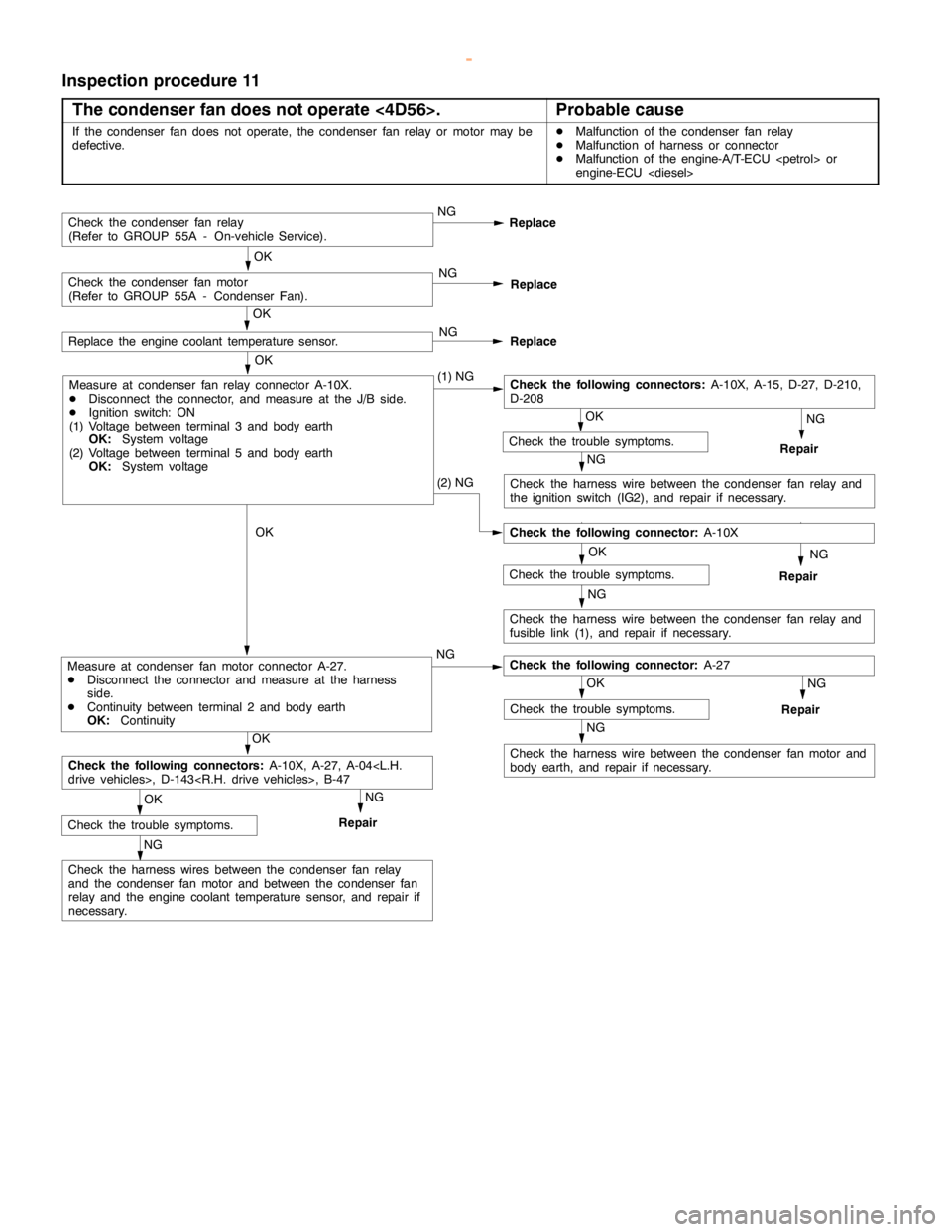2000 MITSUBISHI MONTERO check engine
[x] Cancel search: check enginePage 1732 of 1839

Page 1748 of 1839

55A-2
HEATER, AIR
CONDITIONER AND
VENTILATION
CONTENTS
SERVICE SPECIFICATIONS 3.................
LUBRICANTS 3..............................
TROUBLESHOOTING
TROUBLESHOOTING
ON-VEHICLE SERVICE 9.....................
Refrigerant Level Test through Performance Test 9.
Magnetic Clutch Test 10.........................
Receiver Drier Test 10..........................
Compressor Drive Belt Adjustment 10.............
Dual Pressure Switch Check 10..................
Charging 11...................................
Performance Test 15............................
Front Blower Relay and Rear Blower Relay
Continuity Check 18............................
Continuity Check of A/C Compressor Relay and
Condernser Fan Relay 18.......................
PTC Heater Relay Continuity Check 19...........
Idle-up Operation Check
Vacuum Actuator Check
Idle-up Solenoid Valve Check 21.................
Clean Air Filter Replacement Procedure 22........
FRONT A/C 23..............................
Air Conditioner Control Panel Assembly and
A/C Switch 23.................................
Heater Unit and Blower Assembly 26.............
Blower Motor and Resistor 29....................
Inside/Outside Air Changeover Damper Motor 30...
Automatic Compressor-ECU and
Air Thermo Sensor Assembly 31.................
REAR HEATER AND REAR COOLER 32.....
Rear A/C Switch, Front Rear Fan Switch 32.......
Rear A/C Control Unit 34........................
Rear Heater Unit 34............................
Rear Heater Unit and Rear Blower Assembly 37....
HEAT SWITCH 40...........................
COMPRESSOR 41...........................
CONDENSER ASSEMBLY AND
CONDENSER FAN 45........................
REFRIGERANT LINE 47.....................
ENGINE COOLANT TEMPERATURE SWITCH
51 ..........................................
IDLE-UP SYSTEM 53........................
DUCTS 54..................................
VENTILATION 56............................
www.WorkshopManuals.co.uk
Purchased from www.WorkshopManuals.co.uk
Page 1763 of 1839

HEATER, AIR CONDITIONER AND VENTILATION - On-vehicle Service55A-17
REFRIGERANT LEAK REPAIR
LOST CHARGE
If the system has lost all charge due to a leak:
1. Evacuate the system. (See procedure.)
2. Charge the system with approximately one
pound of refrigerant.
3. Check for leaks.
4. Discharge the system.
5. Repair leaks.
6. Replace receiver drier.
Caution
Replacement filter-drier units must be
sealed while in storage. The drier used in
these units will saturate water quickly upon
exposure to the atmosphere. When
installing a drier, have all tools and supplies
ready for quick reassembly to avoid keeping
the system open any longer than necessary.
7. Evacuate and charge system.
LOW CHARGE
If the system has not lost all of its refrigerant charge;
locate and repair all leaks. If it is necessary to
increase the system pressure to find the leak
(because of an especially low charge) add
refrigerant. If it is possible to repair the leak without
discharging the refrigerant system, use the
procedure for correcting low refrigerant level.HANDLING TUBING AND FITTINGS
Kinks in the refrigerant tubing or sharp bends in
the refrigerant hose lines will greatly reduce the
capacity of the entire system. High pressures are
produced in the system when it is operating.
Extreme care must be exercised to make sure that
all connections are pressure tight. Dirt and moisture
can enter the system when it is opened for repair
or replacement of lines or components. The
following precautions must be observed. The
system must be completely discharged before
opening any fitting of connection in the refrigeration
system. Open fittings with caution even after the
system has been discharged. If any pressure is
noticed as a fitting is loosened, allow trapped
pressure to bleed off very slowly.
Never attempt to rebend formed lines to fit. Use
the correct line for the installation you are servicing.
A good rule for the flexible hose lines is keep the
radius of all bends at least 10 times the diameter
of the hose.
Sharper bends will reduce the flow of refrigerant.
The flexible hose lines should be routed so that
they are at least 80 mm from the exhaust manifold.
It is good practice to inspect all flexible hose lines
at least once a year to make sure they are in good
condition and properly routed.
Unified plumbing connections with O-rings, these
O-rings are not reusable.
COMPRESSOR NOISE
You must first know the conditions when the noise
occurs. These conditions are: weather, vehicle
speed, in gear or neutral, engine temperature or
any other special conditions.
Noises that develop during A/C operation can often
be misleading. For example: what sounds like a
failed front bearing or connecting rod, may be
caused by loose bolts, nuts, mounting brackets,
or a loose clutch assembly. Verify accessory drive
belt tension (power steering or alternator).
Improper accessory drive belt tension can cause
a misleading noise when the compressor is
engaged and little or no noise when the compressor
is disengaged.
Drive belts are speed-sensitive. That is, at different
engine speeds, and depending upon belt tension,
belts can develop unusual noises that are often
mistaken for mechanical problems within the
compressor.ADJUSTMENT
1. Select a quiet area for testing. Duplicate
conditions as much as possible. Switch
compressor on and off several times to clearly
identify compressor noise. To duplicate high
ambient conditions (high head pressure),
restrict air flow through condenser. Install
manifold gauge set to make sure discharge
pressure doesn’t exceed 2,070 kPa.
2. Tighten all compressor mounting bolts, clutch
mounting bolt, and compressor drive belt.
Check to assure clutch coil is tight (no rotation
or wobble).
3. Check refrigerant hoses for rubbing or
interference that can cause unusual noises.
4. Check refrigerant charge. (See “Charging
System”.)
5. Recheck compressor noise as in Step 1.
6. If noise still exists, loosen compressor mounting
bolts and retorque. Repeat Step 1.
7. If noise continues, replace compressor and
repeat Step 1.
www.WorkshopManuals.co.uk
Purchased from www.WorkshopManuals.co.uk
Page 1818 of 1839

HEATER, AIR CONDITIONER AND VENTILATION -Troubleshooting
Inspection procedure 10
The condenser fan does not operate
Probable cause
If the condenser fan does not operate, the condenser fan relay or motor may be
defective.DMalfunction of the condenser fan relay
DMalfunction of harness or connector
DMalfunction of the engine-A/T-ECU
engine-ECU
NG
Check the harness wire between the condenser fan relay and
the ignition switch (IG2), and repair if necessary.
NG
Repair
NG
Check the harness wire between the condenser fan motor and
body earth, and repair if necessary.
NG
Repair
NG
Repair
OK
Replace the engine-A/T-ECU
NG
Check the harness wire between the condenser fan relay and
fusible link (1), and repair if necessary.
NG
Repair
NG
Check the harness wires between the condenser fan relay
and the condenser fan motor, between the condenser fan
relay and the engine-A/T-ECU
engine-ECU
Repair
OK
Check the trouble symptoms.
OK
Check the following connectors:A-10X, A-27,A-04
D-119, D-110<4M41>
OK
Check the trouble symptoms.
OK
Measure at condenser fan motor connector A-27.
DDisconnect the connector and measure at the harness
side.
DContinuity between terminal 2 and body earth
OK:ContinuityNGCheck the following connector:A-27
OK
Check the trouble symptoms.
Check the following connector:A-10X
(2) NG
OK
Check the trouble symptoms.
OK
Measure at condenser fan relay connector A-10X.
DDisconnect the connector, and measure at the J/B side.
DIgnition switch: ON
(1) Voltage between terminal 3 and body earth
OK:System voltage
(2) Voltage between terminal 5 and body earth
OK:System voltage(1) NGCheck the following connectors:A-10X, A-15, D-27, D-210,
D-208
OK
Check the condenser fan motor
(Refer to GROUP 55A - Condenser Fan).NG
Replace
Check the condenser fan relay
(Refer to GROUP 55A - On-vehicle Service).NG
Replace
www.WorkshopManuals.co.uk
Purchased from www.WorkshopManuals.co.uk
Page 1819 of 1839

HEATER, AIR CONDITIONER AND VENTILATION -Troubleshooting
Inspection procedure 11
The condenser fan does not operate <4D56>.
Probable cause
If the condenser fan does not operate, the condenser fan relay or motor may be
defective.DMalfunction of the condenser fan relay
DMalfunction of harness or connector
DMalfunction of the engine-A/T-ECU
engine-ECU
NG
Check the harness wire between the condenser fan relay and
the ignition switch (IG2), and repair if necessary.
NG
Repair
NG
Check the harness wire between the condenser fan motor and
body earth, and repair if necessary.
NG
Repair
NG
Repair
OK
NG
Check the harness wire between the condenser fan relay and
fusible link (1), and repair if necessary.
NG
Repair
NG
Check the harness wires between the condenser fan relay
and the condenser fan motor and between the condenser fan
relay and theengine coolant temperaturesensor, and repair if
necessary.
OK
Check the trouble symptoms.
OK
Check the following connectors:A-10X, A-27, A-04
OK
Check the trouble symptoms.
OK
Measure at condenser fan motor connector A-27.
DDisconnect the connector and measure at the harness
side.
DContinuity between terminal 2 and body earth
OK:ContinuityNGCheck the following connector:A-27
OK
Check the trouble symptoms.
Check the following connector:A-10X
(2) NG
OK
Check the trouble symptoms.
OK
Measure at condenser fan relay connector A-10X.
DDisconnect the connector, and measure at the J/B side.
DIgnition switch: ON
(1) Voltage between terminal 3 and body earth
OK:System voltage
(2) Voltage between terminal 5 and body earth
OK:System voltage(1) NGCheck the following connectors:A-10X, A-15, D-27, D-210,
D-208
OK
Check the condenser fan motor
(Refer to GROUP 55A - Condenser Fan).NG
Replace
Check the condenser fan relay
(Refer to GROUP 55A - On-vehicle Service).NG
Replace
NG
ReplaceReplace the engine coolant temperaturesensor.
www.WorkshopManuals.co.uk
Purchased from www.WorkshopManuals.co.uk
Page 1822 of 1839

HEATER, AIR CONDITIONER AND VENTILATION -Troubleshooting
Termi-
nal No.Normal condition Check conditions Check item
15Rear defoggerRear defogger: OFFSystem voltage
Rear defogger: ON1.5 V or less
16Multi center display unit communication
lineIgnition switch: ONHi: 4 - 5 V
Lo: 0 - 1 V
17Multi center display unit communication
lineIgnition switch: ONHi: 4 - 5 V
Lo: 0 - 1 V
18Multi center display unit communication
line shieldAt all times0V
19Diagnosis outputIgnition switch: ONA voltmeter needle
fluctuates between 0
and 12 V.
20Input from A/C compressor relayWhen the A/C is off.0V
When the A/C is in operation
(When compressor is operating)System voltage
21Power supply to potentiometerAt all times5V
22Input from outside air temperature
sensorSensor temperature: 25
_C (1.7 kW)1.9 V
23Input from heater water temperature
sensorSensor temperature: 25
_C(5kW)2.8 V
24Input from potentiometer for air mix
damperWhen the damper flap is moving to the
MAX HOT position.0.7 - 1.3 V
25Power supply to illuminationLighting switch: ONSystem voltage
26Power supply to ignition switch (IG2)Ignition switch: ONSystem voltage
27Power supply to ignition switch (ACC)Ignition switch: ACCSystem voltage
28Backup power supplyAt all timesSystem voltage
29Earth to sensor and potentiometerAt all times0V
30Input from air thermo sensorSensor temperature: 25
_C (1.5 kW)2.2 V
31Photo sensor (+)During 800 kcal/m2-h1V
32Input from potentiometer for the air
outlet changeover damperWhen the damper flap is moving to the
DEF position.0.7 - 1.3 V
33Diagnosis inputIgnition switch: ON0V
34Compressor lock signal (ignition signal)Engine speed: 3 000 r/min0.3 - 3.0
35Illumination earthAt all timesContinuity
36EarthAt all timesContinuity
CHECK AT ENGINE-A/T-ECU OR ENGINE-ECU TERMINALS
Refer to GROUP 13A – Troubleshooting
www.WorkshopManuals.co.uk
Purchased from www.WorkshopManuals.co.uk